It’s been a strange year for mortgage originators. Actually, it’s been a few strange years. If 2020 could be put in the category of a completely unexpected windfall, then 2021 would probably fall into the category of an unexpected extension of the same. What could 2022 have in store?

Here’s what is known: Credit availability has decreased, home-price appreciation is starting to slow down and may even be headed for a correction, interest rates are expected to continue to rise and refinance volume has already started to taper off. To put it one way, these aren’t just signs that the mortgage business is headed for a purchase-oriented market — it’s a single-lane road that leads to “Purchaseville” and has no offramps in sight.
What does this mean for originators? You’d better have a great game plan for the coming year if you want to succeed, and this plan should have a purchase-loan business strategy at its heart. When originators think about strategy, it’s typically in one of three ways:
- How do I get my next loan?
- How do I grow my personal brand?
- How can I reduce time on busywork so I can spend more time selling?
Here is a fourth option, one that may appear to be a longer-term strategy but will ultimately pay greater dividends than any of the previous three: Find out what delights your clients. In other words, what is it exactly that takes them from just liking you to referring you to their friends and family, thus driving new business to you? In the same way, find out what irks your clients, keeps them from singing your praises and stops them from encouraging others to come to you for their home loan.
Pivot points
A mistake that many originators make is thinking that a pleasant smile and a handshake at the end of the loan process will somehow magically turn into referrals down the road. Unfortunately, expecting a borrower to recommend you after enduring a less-than-delightful loan process is equivalent to expecting a restaurant patron who received mediocre food to recommend the restaurant just because they liked the waiter.
Creating a raving fan takes a lot more work. It starts with a process that is easy, error-free and convenient — and, ideally, by creating an experience that is memorable and personal. Just as a restaurant experience can be soured by an overcooked entrée or an error on the bill, a loan process can be soured by events that may not even be on your radar. Knowing these potential pivot points from the “happy path” to the “unhappy path” could make all the difference in whether 2022 is your best or worst year yet.
So, how do you find out what’s really making your borrowers tick? What factors in the loan process determine whether your borrowers are delighted or disgruntled?
Communication missteps
Stratmor Group surveys in 2021 of more than 200,000 borrowers found that most pivot points from the “happy path” to the “unhappy path” in the loan process tend to come down to communication (or lack thereof). The result is not only a breakdown of the loan experience at hand but the sabotage of future business opportunities that are typically sourced from repeat and referral business from that client.
Take, for instance, the way you choose to update borrowers on their loan status. These days, many mortgage companies have built-in, automated emails for this task, and two in three borrowers cite these emails as the main way they receive updates, according to the survey. The problem is that the communication style of these emails is rarely as casual or as friendly as a personal outreach by phone or text. Evidence for this shows up in the net promoter score (NPS), which measures how likely the borrower is to recommend you to their friends and family on a scale of minus 100 to 100.
Somewhat surprisingly, texting (with an NPS of 83) comes out on top as the most “delightful” way to receive loan updates, surpassing even personal phone calls. This is a new trend that may be attributable to the fact that texting is the preferred method of communication for millennials, who accounted for more than 50% of all purchase mortgages in the past year. Unsurprisingly, borrowers who had to call in to receive loan updates scored a damaging minus 12 for NPS.
Another communication misstep comes toward the end of the loan process — the failure to call a borrower prior to closing to go over the final figures and details. Forgetting or failing to make time for this task costs 92 points on the NPS scale, flipping a would-be promoter (someone who will refer business) into a detractor (someone who will actively turn people away from you).
An error that saw a huge uptick over the past 18 months was a failure to set proper expectations around the closing time frame. This happened on a whopping 21% of mortgages in 2021, up from 12% pre-pandemic. Even with a recent reduction in cycle times, this continues to be a major pain point for clients, whose expectations are shifting, too. The cost for failing to set proper expectations? A decrease of 54 points on the NPS scale. This means that for every two loans with this issue, one would-be raving fan jumped ship and badmouthed you instead.
Referral lifeline
When your borrowers aren’t actively complaining, it’s easy to let seemingly insignificant details slide. After all, having a few clients here and there who are underwhelmed with the process can’t hurt much, so long as they’re happy with you, right? Wrong. The danger in this line of thinking is that it fails to recognize that the creation of raving fans has much more to do with the entire loan process than the originator alone.
Remember the restaurant analogy? Referrals will be your lifeline in 2022. When midyear arrives, you will be glad to have had the foresight to put practices into place that will delight your borrowers, resulting in a pipeline that is healthy and full. There are simple ways to set yourself up for a highly profitable 2022 and beyond.
Set expectations upfront around transparency and communication. In the initial conversation with a borrower, ask how often they want to be informed about loan status and their preferred means of communication. This shows them you care about their unique set of needs and creates a foundation of trust. Then set recurring reminders on your calendar and follow through.
Detail oriented
Keep a close eye on the loan process. This requires high visibility, so the first step is to make sure your company is using a post-closing survey process that captures insights about the entire lending process.
Many originators make the mistake of thinking that a high personal-star rating, or even a client testimonial, will guarantee future referrals. The truth is that seemingly minor missteps can severely damage the client’s likelihood to recommend you. Whether a misstep is your fault or not, you are the one who suffers from lost referrals. The only sure way to produce raving fans is to create a delightful loan process from A to Z. Borrowers who complete the closing without any critical missteps have an NPS of 96.
Use digital tools such as texts or embedded videos to provide quotes and go over closing numbers. If you’re not using these slick new tools, you can be sure that someone hungrier and savvier than you will be gunning for your business. Bite the bullet and tackle the digital learning curve head-on.
Treat borrowers like referral partners. When you meet with a referral partner for the first time and they send a client to you, you naturally consider it their first referral. Have the same mindset with your borrowers. In casual conversation, refer to the loan as “our first loan together,” which creates a subtle understanding that there will be more loans in their future and that you plan to foster a long-term relationship with them. Words matter.
The bottom line? Proactive, personalized communication with the borrower — from the time an application is received through the underwriting process and the loan closing — is the key to creating delighted clients.
● ● ●
Setting the right expectations, communicating in the way the borrower prefers and scheduling a phone call prior to closing will all go a long way to ensuring your borrowers are not only satisfied but delighted. Although these tasks may seem simple, many loan originators aren’t taking the time to do them and are missing out on long-term business relationships.
In the end, the mortgage professionals who follow this road map will have a wellspring of referrals to sustain and grow their business in 2022. And remember, each referral that you receive presents an opportunity for you to create another raving fan. ●
Author
-

Mike Seminari is the director of customer experience for Stratmor Group, a data-driven mortgage advisory firm offering its clients expert advice on strategy design and execution, mergers and acquisitions, and marketing and sales operations optimization and technology. Seminari has more than 25 years of business- to-consumer and business-to-business experience in the mortgage and technology industries. He has grown Stratmor’s customer experience practice into an industry leader in the drive to optimize the mortgage borrower’s experience.
View all posts







